Two Recent FCC Actions Highlight Chronic Concerns That Spectrum Policy Resources at FCC Are Too Low
Field Enforcement
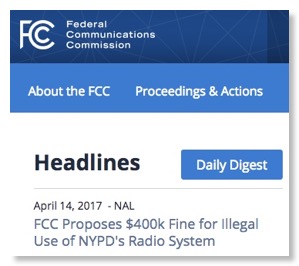
- "On August 1, 2016, the Commission was alerted by a posting on Twitter about an unlawful intrusion on the NYPD’s radio system, whereupon the Enforcement Bureau dispatched an agent from its New York Field Office (New York Office) to confirm the intrusion and offer assistance."
- "On September 30, 2016, the NYPD contacted the New York Office and advised that it had arrested two individuals, Mr. Peralta and an accomplice, in connection with unauthorized transmissions made on the NYPD’s radio system."
Does the downsized New York FCC field office have the resources today to have helped NYPD to solve this case had they been asked?
When I was in EB's predecessor, FOB, one of the top priorities of field officer managers was to maintain good relations with local public safety officials so that they could help quickly with public safety interference issues that were of the highest priority then and well as now. So why didn't NYPD tell FCC about this case? Perhaps top FCC officials should ask why! (I suppose the FCC IG could look into to it, but we all know that unlike Curious George he is not at all curious about FCC operations that risk discovering something embarrassing to agency leaders. He is a great team player though!)
Should we look forward to this $404,166 NAL helping to reduce the national debt? Don't count on it. EB is rather evasive about how many NALs are actually paid and this type of fine against an individual has little likelihood of a substantial recovery. Perhaps a more relevant question is why this didn't result in a § 333 criminal prosecution? Now US Attorneys are reluctant to get involved in Communications Act cases involving interference to TV reception or amateur radio shenanigans, but this sounds like what § 333 was intended for and was also a criminal violation of § 301. When I worked in the old FOB, I was personally involved in 4 different successful criminal prosecutions for radio violations (2 satellite jamming cases, 1 aviation air traffic control intrusion case, and 1 maritime false distress case) during a 5 year period. It is unclear when EB was last able to ask and convince DOJ to prosecute any case, perhaps 20+ years ago? Does EB even know how to make such a request to DOJ? Does it even have the files on the old successful FOB referrals to DOJ?
Part 5 Experimental Program Licenses
On April 14th FCC's blog had a new post from OET Chief Julius Knapp entitled "Open for business: FCC's New Experimental Licensing System Accepting New Applications". It failed to mention the origins of this new program, probably because the timing might be embarrassing. On January 31, 2013 FCC adopted the Report and Order in Docket 10-236 updating the Part 5 Experimental License Program. (Note this was 26 months after the NPRM had been adopted — indicating that this docket was not exactly on the fast track. However, both the NPRM and the R&O were released on the day the Commission adopted them indicating FCC leadership was trying to maximize PR since this is treatment only PR-worthy decisions get due to perennial FCC "back office " problems. )
The R&O said about the new types of licenses:
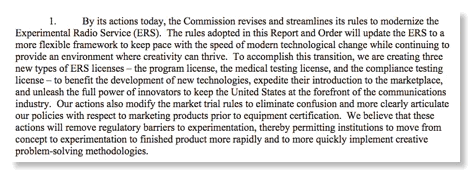
These are all commendable goals but the 4+ years delay between the adoption of the R&O and the opening of the updated application web site that accepts applications is unexplained. There are some plausible issues dealing with a reconsideration of the R&O which was itself on the "slow track" and was slowed further by a 2 month delay in publishing the R&O in the Federal Register. OMB approval was needed for some details of the new website since it gathered information. But the most likely explanation for much of the years of delay was the lack of resources in FCC to modify the website that handles experimental applications. Indeed what was actually done was to add a new section/dashboard so that the basic experimental license website created in the 1990s remains unchanged. (It was state of the art 1990s technology in how it implemented the FCC Form 442 of the era but is a now real pain to use for even simple applications for anyone who doesn't use it on a regular basis due to design quirks and poor instructions.)
So both of these problems are probably cause by chronic low FCC funding for spectrum policy issues other than auctions and 5G. While certain FCC Title II activities are controversial, Title III activities generally are not. Indeed, Title III is both a profit center for the Treasury and a major growth enabler for the GDP. Why far the resources for FCC in this area so low that key activities are not adequately funded. Note that this is a bipartisan issue and both parties are responsible!
The WTB Auction Division is adequately funding because it can "skim" off auction proceeds. (When I was working at FCC many people noted that all the staff in the Auction Division had large displays on their PCs because their were supposedly needed for auctions - even for time clerks?) Ofcom is not funded by an appropriation from the UK Parliament, it is funded by the fees it collects subject to limits set by the agency that supervises it. Perhaps it is time to try to remove the spectrum regulation of FCC from regular politicized appropriations process since it is already supported by various spectrum fees? Recall that Wi-Fi, Bluetooth, and many other unlicensed marvels all started with a $55,652 FCC-funded study at MITRE Corporation in 1980 and today's reality is that FCC can not afford studies of new technology options and can't even afford its own spectrum enforcement activities and implementation of new rules!
FCC-CIRC#1
A New Procedure for FCC:
ATSC 3.0 Issues
Now this can be resolved simply by specifying a vaguely transparent mechanism for giving feedback on these drafts, whether it is ECFS or a more informal system. Should there be some "paper trail" of what the feedback was or who gave feedback?
But here are my views on FCC CIRC #1, shown above. This is a draft NPRM "Authorizing Permissive Use of the 'Next Generation' Broadcast Television Standard" called ATSC 3.0. Readers of this blog know that there is no greater supporter of Section 7 of the Communications Act which deals with new technology. Thus it is amusing to note that even though NAB explicitly raised the issue of Section 7 on p. 1 of its petition:
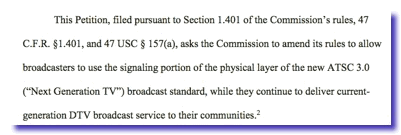
that he draft NPRM actually never mentions the Section 7! Did the FCC staff that drafted it not notice that Chmn. Pai's very first speech as a commissioner dealt explicitly with the Commissioner's failure to use this law signed by Pres. Reagan 30+ years ago? In that speech, then Comm. Pai said:

So since NAB raised it, why doesn't the NPRM deal with the Section 7 issue?
(Perhaps NAB is "entitled" as a "professional courtesy" to the same superfast treatment that CTIA received for 5G. FCC staff may be afraid of even citing Section 7 for fear of setting a precedent that less entitled entities might seek to use. Previously FCC set an odd precedent that one is never entitled to Section 7 treatment unless the issue was raised from the very beginning. NAB's, perhaps unintentional, mention of Section 7 may thus be creating problems for the Section 7 deniers on the FCC staff and in certain industries. But isn't Section 7 the "law of the land"?)
Another issue with the present draft is its exclusive focus on the positive aspects of the NAB petition. Unfortunately a transition to ATSC 3.0, like many other spectrum policy transitions, has a transitional period that has some pain for those involved. In the DTV transition this was minimized by giving each broadcast a 2nd channel so they could simulcast on the 2 incompatible technologies. There were originally 82 TV channels. At the time of the DTV transition there were 67. Now there are 49 and it is simply impossible to have full parallel simulcasting in 2 different standards now. So the petitioners and the draft NPRM ask for the requirement that those broadcasters voluntarily turning off their ASTC 1.0 signal to use ATSC 3.0 must maintain coverage by arranging for continuing ATSC 1.0 coverage in their service area on the multiplex streams of a remaining ATSC 1.0 broadcaster. This is feasible because an ATSC 1.0 system broadcasts a 19 Mbps digital stream that can be divided up several ways. Thus if you have a DTV receiver and a physical antenna you may notice channels like 4-1, 4-2, and 4-3. (I have one on my sailboat!) These are 3 different video signals multiplexed together to the same 6 MHz TV channel. (In this case the TV is apparently tuned to "channel 4", but likely a different physical channel number that the TV set learned during initial setup is the physical frequency used for the signal.) Channel 4-1 is the main signal of the TV broadcasters, so in DC and many other cities it is the NBC affiliate. The other 2 are video streams of lesser technical quality, often old analog programming, that the broadcaster makes a little extra money out of. In some cases the other sub channels have novel programming of local interest.
Now para. 11 of the NPRM draft raises this issue a little:
"If the simulcast content will not be identical to the originating station’s primary video programming stream, we ask commenters to explain the reasons for any deviations in content and/or format (HD) versus SD) and the impact of such deviations on television viewers and the regulatory implications."
But the text of the NPRM draft does not discuss what this means. The technical quality of a DTV signal on a consumer's TV set depends greatly on how many bits/s are provided for that signal. By packing multiple network TV signals on a single 19 Mbps ATSC 1.0 signal it is very possible that the bit rate of a given network signal will decline from present practice and hence the signal quality will also decline. For some types of programming this may not be apparent, e.g. talk shows like "Meet the Press". But for more action programming, e.g. James Bond films and football, the degradation will be apparent. This is not discussed at all.
If the remaining ATSC 1.0 stations during the transition previously had multiple subchannels and the channel's moving ATSC 3.0 also had subchannels, will many of those sub channels and their diversity disappear during the transition? Presumably this is part of the question in para. 11, but it isn't clear.
Now depending if you want to believe NAB or not, 80-90% of US households do not have a physical TV antenna and get video programming from MVPDs. This large fraction of US households will see little or no impact from the NPRM. However, NAB claims this MVPD market share is decreasing and is even giving away free antennas to expedite that decrease. The draft doesn't discuss this bifurcation of US households and the varying impact on them.
(Para. 4 explains that MVPD is an abbreviation of "multichannel video programming distributors", but explains it no further. As a public service, here is a Wikipedia link that explains for the non-FCBA members what this specialized term means. We believe that a 49 page NPRM that will affect millions of US households should have room for a sentence or two explaining such jargon.)
The draft asks in para. 71-73 about possibly requiring all future TV receivers to include the new ATSC 3.0 technology. The draft accepts the NAB suggestion:
The Petitioners assert, however, that the Commission should not mandate Next Gen TV tuners in television receivers at this time,but should instead allow the marketplace to dictate the availability of television receivers with a Next Gen TV tuner.
But it does ask questions about a possible consumer receiver mandate under the provisions of the 1962 All Channel Receiver Act. Nowhere in this discussion is there any viewpoint other than "manifest destiny" for new broadcast technology. For example there is no mention of the market place failures for previous NAB boosted technology such as AM stereo or HDRadio. Indeed the market failure of AM stereo was not only in the US, but worldwide under a variety of regulatory policies! In today's fast changing world of digital electronics do such mandates make any sense? This is an issue not in the present draft.
We support the basic idea of this NPRM, but take advantage of this opportunity to urge the Commission to consider the above issues in drafting the final version. We also urge it to clarify how they want to receive feedback on such drafts.
UPDATE
Draft agenda items that are released prior to their adoption now give this statement at the bottom of their first page:
This document has been circulated for tentative consideration by the Commission at its April open meeting. The issues referenced in this document and the Commission’s ultimate resolution of those issues remain under consideration and subject to change. This document does not constitute any official action by the Commission. However, the Chairman has determined that, in the interest of promoting the public’s ability to understand the nature and scope of issues under consideration by the Commission, the public interest would be served by making this document publicly available. The FCC’s ex parte rules apply and presentations are subject to “permit-but-disclose” ex parte rules. See, e.g., 47 C.F.R. §§ 1.1206, 1.1200(a). Participants in this proceeding should familiarize themselves with the Commission’s ex parte rules.
This certainly clarifies what the procedures are.
Oddly, draft items are only released in .txt and .pdf formats while adopted items are relate in both of these as well as .doc format. it is puzzling why final documents have 3 formats and draft only have two. MS Word comes with a free document comparison tool which could be used to see what changes are made in a draft before adoption and compare them with ex parte filings. This can be done with .pdf version, but requires finding the right software tool.
2 Unsung FCC Pioneers in Early 5G #HighBandSpectrum Policy
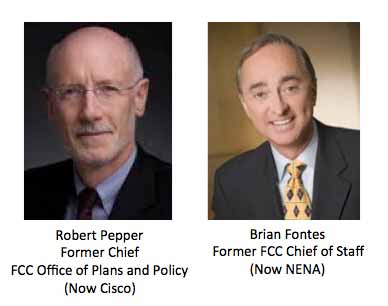
(UPDATE: Robert Pepper is now with Facebook)
There is an implicit viewpoint at FCC that telecom technology is like a "conveyor belt sushi"/kaitensushi /回転寿司 restaurant in Japan: you sit at the counter and various types of sushi come on a conveyor belt in front of you unordered and you just wait until you see one you like and then take it off for eating. So at FCC you just wait for telecom technology to magically come from a conveyor belt and you pick winners and ignore the losers.
Video on "conveyor belt sushi"/kaitensushi /回転寿司 in Japan from NHK
Well, telecom technology does not come by magic! It requires bright people with good ideas and then investment in R&D to work on such ideas. In radio technology, the risk of that investment and thus its commercial likelihood depends on regulatory risk of FCC approving the commercial use and hence profitability of the technology.
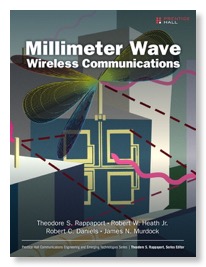
"it took about ten years for low-cost commercial products to evolve from 1998 (sic) when USA became the first country in the world to authorize low-power 60 GHz operation…(S)hort range wireless networks provided the relevant applications to take advantage of unlicensed 60 GHz spectrum, as well as other frequencies in the mmWave band…Due to the inherent nature of mmWave frequencies … many emerging or future mmWave wireless products and standards (such as 5G mmWave cellular, inter vehicular communications, and backhaul/fronthaul communications standards) are likely to share characteristics with the 60 GHz WPAN/WLAN standards.
Thus #HighBandSpectrum 5G did not come unsummoned from a sushi conveyor belt, but derived from earlier visionary FCC action in Docket 94-124 in the Hundt Chairmanship. In my main website I have given more background of how this came about, here let me emphasize the role of the 2 individuals shown above.
When I proposed the concept of a 60 GHz unlicensed band in late1992 to the leadership of FCC's Office of Engineering and Technology, it was immediately rejected. This was probably because of the FCC culture related to "Nobody every got fired for buying IBM", i.e. if you only do things major regulatees propose you can never be criticized. (At the time I was working in EB's predecessor FOB as part of an "internal exile" resulting from the Docket 81-413 proceeding that is now known as the basis of Wi-Fi and Bluetooth but which at the time was very controversial.)
After the OET rejection, I sought guidance from Dr. Robert Pepper - legendary Chief of the FCC's Office of Plans and Policy (now OSP) from 1989 to 2005 - an amazing tenure in a very partisan agency. Bob was interested in the idea when I presented it to him, he asked me many questions and then proposed a meeting with the Chairman's Office to discuss the issue. This was during the Quello Chairmanship and Dr. Brian Fontes, his long term staffer was his Chief of Staff. Bob came with me to the meeting with Brian and the then Chief of OET. We both gave our viewpoints and Brian agreed with me that we should start drafting an NPRM for unlicensed use of 60 GHz - far above the then upper limit of FCC radio service rules at 40 GHz. The NPRM was drafted and approved on 10/20/95 under Chmn. Hundt who succeeded Quello. The R&O was adopted on 12/15/95 and by that time both Dr. Pepper and Dr. Fontes had left FCC after many years of loyal service.
Bob is now Vice President, Global Technology Policy at Cisco. Brian is now Chief Executive Officer of the National Emergency Number Association.
I hope that the 5G community can now remember that these two gentlemen played a key role in the early development of 5G #HighBandSpectrum policy in starting the "conveyor belt" moving at a time when the cellular mainstream had little or no interest in upper spectrum bands and thus giving us the wonderful technology that was approved yesterday!
CTIA & NAB Demand Quick Action on Their New Technologies
While FCC Goes Slow on Everyone Else's!
Broadcasters Push for ATSC Decision By Oct. 1: https://t.co/fGXq4RNQu4
— Broadcasting & Cable (@bcbeat) June 28, 2016
Learn why the @FCC should vote next month to allocate #HighBandSpectrum for #5G innovation https://t.co/Otwc2S3cSX
— CTIA (@CTIA) June 28, 2016
In the above pair of tweets CTIA and NAB demand quick action on their favorite new technologies. NAB even has the chutzpah to invoke Section 7 of the Communications Act - a topic that FCC has tried careful to avoid for 30+ years. As we have written previously, there is even an opinion among FCBA members that trying to invoke Section 7 will result in additional delay!
Mitch Lazarus in his "Wireless Innovation" NOI comments pointed out the chilling effect FCC delays and regulatory uncertainty have on technical innovators. He stated in thiose comments:
The Commission's Rules are based largely on the technologies in place when they were written. New radio-based technologies often fail to satisfy those rules. The more novel an innovation, the lesslikely it is to comply. In consequence, a new wireless technology may need a Commission rulemaking or a waiver before it can reach the market. Technical proceedings in general, including those to authorize new technologies, have been dismayingly slow." (Emphasis added.)
Lazarus gives 11 examples of noncontroversial technologies that dragged on in FCC deliberations for years. He comments
"For a pre-revenue company burning through investors’ cash, having to wait two or three years for the first sales dollar can be a deal-breaker. Some companies give up at the starting line. Others try to go forward, but not all of them make it. One of my clients, dependent on a single product, went out of business waiting for Commission action. Others, though they survive, worry that their product will be leapfrogged by competing technologies and be obsolete on release. Even if all goes well and the product eventually sells, it still has lost considerable time on the market, which nowadays is short enough anyway."
I have elaborated on this issues in my paper at last year's TPRC on FCC's spectrum policy productivity. I concluded in the paper that the these long delays result from BOTH low funding of FCC spectrum policy staffing as well as an FCC organization structure which has not kept up with the explosion of spectrum technology options in parallel with the growing burdens of the APA as its case law expanded.
So while I have no objection to innovation from NAB and CTIA members, even timely action on such innovation, isn't time to treat all innovation in a timely way? Should FCC use the Chevron Doctrine to share with the public what it believes the true meaning of Section 7 is and how it will deal with new technology? While corporate mergers have no such statutory mandate, FCC has clear guidance on how it will deal with them. Why not comparable public guidance on new technology also?
While FCC publicly gloats above "changes to its rules and procedures to improve the timeliness and transparency of the review process for certain applications and petitions for declaratory rulinwith
reportable foreign ownership", should new technology consideration get comparable reforms? Why not streamline new technology also?
There seems to be a consensus now that the unlicensed ISM bands created in 1985 by FCC with a combination of indifference and hostility from spectrum incumbents at the time has had great economic benefits, perhaps adding $140B/year of economic activity. Would today's FCC spend any decision making effort on such a proposal that not only wasn't backed by major trade associations, but was even opposed by several of them?
Todays interest in "Upper Spectrum Band" 5G results from R&D that was greatly stimulated y the rules adopted in Docket 94-124 in the 60 GHz band. CTIA members did not even participate int hat rulemaking, no doubt because it seemed so esoteric at the time. But today they are reaping huge benefits from the R&D it stimulated.
Is it wise for today's FCC to pursue only technology innovation initiatives backed by these major trade associations?
Your thoughts are welcomed in comments
Will FCC Punish NAB for Raising the §7 Issue in Its ATSC 3.0 Petition?
New technologies and services
(a) It shall be the policy of the United States to encourage the provision of new technologies and services to the public. Any person or party (other than the Commission) who opposes a new technology or service proposed to be permitted under this chapter shall have the burden to demonstrate that such proposal is inconsistent with the public interest.
(b) The Commission shall determine whether any new technology or service proposed in a petition or application is in the public interest within one year after such petition or application is filed. If the Commission initiates its own proceeding for a new technology or service, such proceeding shall be completed within 12 months after it is initiated.
Indeed, a prominent communications attorney in private practice told me a few years ago that FCC would punish any party who had the temerity to claim entitlement to timely action for new technology under this provision by delaying any action even more than usual! (As Mitchell Lazarus showed in his comments in the still pending after 7 years "Innovation NOI", Docket 09-157, 2-5 year delays are common even for noncontroversial policy changes for new technology!)
Along the same lines, a senior current 8th Floor staffer told me that mergers at FCC should get higher priority than new technology issues because mergers add more to the US economy! (Note this staffer was not from Comm. Rosenworcel's staff since she believes that FCC's past unlicensed spectrum decisions "contribute $140 billion in economic activity annually".)
Your blogger is not opposed to mergers or FCC merger reviews, just puzzled why merger reviews have a published timetable that is usually met while the provisions of § 7(b) are consistently ignored.
But my unnamed lawyer friend does not represent NAB and its ATSC 3.0 copetitioners. Thus my surprise when I read this introductory section of NAB's ATSC 3.0 Petition for Rulemaking.
Did NAB touch the "third rail" of FCC policy deliberations: § 7 ? Will FCC punish NAB for claiming Section 7 status?
Actually various senior FCC staffers over the years have said this is not a problem because "everyone knows" that § 7 is just advisory and doesn't mean what its plain language says it means. Well apparently NAB and its copetitioners Association of Public Television Stations, AWARN Alliance, and Consumer Technology Association (former CEA) didn't know that! But if such knowledgeable groups as NAB and CTA were fooled by the apparent plain language of § 7 isn't it reasonable that an "outside the Beltway" startup might also believe what the law appears to state?
Isn't time for FCC to take the Chevron decision precedent and state clearly what it really thinks § 7 means? Clearly a lot of people are confused here. If FCC decides after 30+ years that § 7 needs updating or clarification, it has an annual opportunity to ask Congress for such changes. To my knowledge it never has, preferring to ignore the issue.
Will FCC punish NAB with extra delay for having raised this ugly issue as my unnamed friend predicted? NAB is nowhere as powerful it was two decades ago since CTIA is clearly the alpha male of FCC regulatees these days. (You don't see CTIA raising § 7 issues - they don't have to in order to get their way!)
Broadcasters no longer "alpha male" at FCC
.@youtube: “we reach more 18-49 year olds during primetime than the top 10 TV shows combined” https://t.co/9xjRY3sGQP
— CTIA (@CTIA) May 6, 2016
But acknowledging the § 7 issue in any FCC action on this petition would be very awkward for the § 7 denialists at FCC who redact the section from all paper copies of the Comm Act on 12th St., SW and use the FCC "great firewall" to keep the staff from finding it on WestLaw.
Perhaps FCC insiders can convince NAB et al. to quietly amend their petition and bury this awkward issue?
Comm. O'Reilly's Post on "Defending Capitalism in Communications"
American capitalism, and its role in the communications industry,[1] should be embraced, celebrated, and exported throughout the world. Instead, it is under continuous assault domestically by self-defined progressives and ultra-liberals, who have found sport in using misguided rhetoric and false pretenses to denigrate one of the core tenets of American society. They demonize company executives, decry profits and income, promote class warfare and push policy positions favoring government-provided services over private sector solutions. Beyond being disingenuous and inflammatory, these views completely ignore the extraordinary benefits that the American capitalistic system brings to communications services.
Without proper checks and reassertion of our commitment to free enterprise, the latest anti-capitalism talk risks seeping into Commission proceedings and underlying activities. In fact, signs of it can be seen in multiple Commission proceedings, from municipal broadband advocacy to the harmful net neutrality overreach. The following briefly explores just some of the benefits of capitalism.
There are then 5 sections:
1. Connects Willing Buyer and Seller in Marketplace
2. Minimizes Need for Government Interference
3. Protects Consumers Efficiently and Sufficiently
4. Facilitates Profits and Economic Growth
5. Fosters Entrepreneurialism
Your blogger has posted this comment to Comm. O'Reilly's posting
You did not explicitly mention the issue of technical innovation and FCC, but I think this is consistent with your general view. Despite decades of FCC deregulation enabling "permissionless Innovation" there are technical areas where FCC has not been able to develop such a framework. Some technical innovations still require "Mother, may I .." requests to FCC.
Thus the iPhone was introduced with only fast routine FCC approvals but the issue of ANY use radio technology above 95 GHz is the exact opposite requiring non routine approvals with no particular time schedule. While many criticize FDA New Drug Approval procedures, FCC's procedures for new technology requiring unusual approvals is worse in many ways. At least FDA has nominal schedules for NDAs and tells applicants what is needed in their requests
FCC has had before it a petition for a declaratory ruling from IEEE-USA on the issue of whether technology above 95 GHz should be presumed to be "new technology" in the context of Section 7 of the Communications Act. (Note that since 2003 FCC's radio service rules have ended at 2003 GHz and therefore new rules are needed for any type of licensed or unlicensed transmitter above that frequency.) This petition was filed in July 2013 and in January 2016 it was revealed that 2.5 years after filing it is circulating on the 8th Floor. TRDaily reports that the draft says that Section 7 requests should always be handled on a "case by case" basis. Oddly in the 30+ years since Section 7 was signed into law by President Reagan FCC has not found one "new technology"!
A basic precept of capitalism is that innovators should be able to get new products and services to market in a timely way and let the marketplace decide on their merits. Many people agree that this should be tempered somewhat for products and services that may cause harms. But the endless delays that FCC imposes on new technologies not in areas subject to "permissions innovation" are generally independent of harms to others.
FCC has pledged to deal with corporate mergers on a timely schedule with online status tracking. As far as I am aware there is no statutory mandate for this timely consideration but FCC has chosen to do it as a matter of good public policy. However, Section 7 does give a clear legislative mandate that "It shall be the policy of the United States to encourage the provision of new technologies and services to the public. Any person or party (other than the Commission) who opposes a new technology or service proposed to be permitted under this chapter shall have the burden to demonstrate that such proposal is inconsistent with the public interest." Further Section 7(b) requires " The Commission shall determine whether any new technology or service proposed in a petition or application is in the public interest within one year after such petition or application is filed." This is not a perfectly drafted piece of legislation, but are all other parts of the Communications Act that much clearer?
For 30+ years under leadership of BOTH parties FCC has been trying to dodge these mandates. FCC has never asked Congress to modify or clarify or even remove them.
Is this timeliness needed? Look at the examples given by Mitchell Lazarus, a prominent communications law practitioner specializing in innovative radio technology, in his comments in Docket 09-157 of noncontroversial radio innovations that were delayed for years.
Look at the Petition for Rulemaking filed by Battelle Memorial Institute more than 2 years ago for use of a 105 GHz point-to-point system in a band beyond the FCC's 95 GHz limit but consistent with all US spectrum allocations. While this has been mentioned in both the NOI and NPRM in Docket 14-177 there has been NO action on either implementing the proposal or rejecting it. Meanwhile our foreign competitors are targeting spectrum above 95 GHz for commercial use with industrial R&D support and with proposals adopted at WRC-15 (without US participation) to create new ITU spectrum allocations in 275-450 GHz at WRC-19.
Thus the concepts of capitalism require that new products and services must get a timely market test unless there is a real reason to stop them. While many such products and services are now subject to "permissionless innovation" at FCC, many are not. FCC should implement procedures to deal with them in a timely way or be prepared to give technical leadership to our foreign competitors.
Europe and Asia Propose Extending ITU Radio Regulations to 1000 GHz at WRC-19
US Silent
FCC stalled at 95 GHz

Our friends at the UK's PolicyTracker, a spectrum-focused newsletter with world wide coverage, have given us kind permission to reprint the article below by Toby Youell that first appeared on their website on October 2.
Radio Regulations may be extended up to 1000 GHz at WRC-19
Two proposals for new agenda items at WRC-19 could lead to the Radio Regulations extending the upper limit for transmissions from 275 GHz to as much as 1000 GHz.
These frequencies are currently only governed by a footnote (5.565) that allows for the protection of receive-only applications such as the radio astronomy, Earth exploration satellite and space research services.
But according to a new proposal from the Asia Pacific Telecommunity, the ITU-R should “study potential candidate frequency bands for use of the land mobile and fixed services” between 275 GHz and 1000 GHz. Similarly, Europe's common proposal for agenda items at WRC-19 invites the ITU-R to “identify candidate frequency bands for use by systems in the land mobile and fixed services” in bands up to 450 GHz.
Gerlof Osinga, vice chairman of the European (CEPT) conference preparatory group, told a recent ITU inter-regional workshop on WRC-15 preparation that the 450 GHz limit was intended to limit the amount of work that would need to be done in the next study cycle.
According to both draft resolutions, using frequencies higher than 275 GHz may become viable as technology develops. Ultra-high-speed data communication systems demonstrated by some research and development organisations can already transmit at a speed of 100 Gbps above 275 GHz, CEPT says. IEEE task group 802.15.3d is developing standards for wireless personal area networks (WPANs) at these frequencies. One use case could be wireless links in data centres.
Initial studies of technical and operational characteristics of services operating in the 275–1000 GHz range have been undertaken by ITU-R Working Party 1A, while ITU-R Study Group 3 has studied the propagation characteristics of these bands. But according to documents submitted for WRC-15, sharing and compatibility between passive services and potential active applications in the bands has not yet been studied at ITU level.•
In view of the pending "Spectrum Frontiers" NPRM at FCC, why can't FCC think beyond the present 95 GHz upper limits of FCC radio service rules - a limit that was reached in 2003.
Discussions with FCC/IB staff have confirmed there is nothing comparable to this in US proposals. Does this indicate a structural flaw in US WRC preparation process? We think so as this is not the first time that US WRC proposals have focused in cliques well represented in WRC preparation and ignored other public interest issues. More later.
UPDATE
The CEPT and APT proposals for new spectrum beyond the present 275 GHz ITU limits can be downloaded here.
Europe and Japan March Ahead in Millimeterwaves with their State Capitalism Spectrum Model While FCC Hesitates
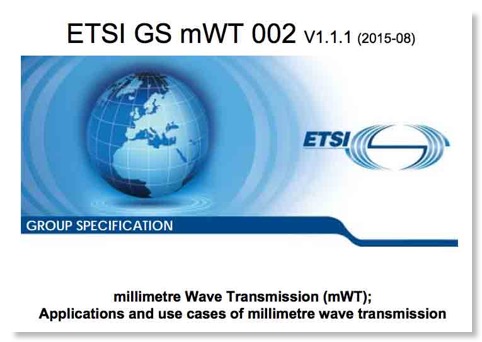
We have previously written about the FCC's "War on Millimeterwaves" - the inaction on moving the upper end of spectrum regulation above 95 GHz where it has been since 2003. Why invest in such new technology when you have no idea when FCC will allow market access? There are lots of other new technologies out there, some FCC regulated and others with different types of regulation, where either no government approvals are needed for new technology or where the needed approvals are both timely and transparent. Unless you are a masochist, why limit yourself to FCC-regulated technology and certainly why invest in a technology where there is "no light at the end of the tunnel". FCC's "blind eye" to the statutory requirements of Section 7 of the Communications Act to act in a timely way on "new technology" isn't helping either.
So let's look at what our national economic competitors are doing. The new report shown at the top of this page is from ETSI, the European Telecommunications Standards Institute. While this might sound like ANSI, its US counterpart, ETSI is really very different in that Europe's telecom regulators are key members and CEPT, the organization of Europe's "FCC's" had a key role in starting it. Also note that in Europe national and EU regulations often permit the use of equipment meeting ETSI standards, e.g. GSM and DECT, and forbid alternative technologies such as those developed and sold in the US.
In this document Europe Inc is making a roadmap for millimeter wave technology and it is clear that the same Europe Inc. is subsidizing the R&D of this technology. Here is part of the discussion of what this technology can be used for:
A variety of wireline as well as wireless technologies are available to build transmission infrastructures and usually a mixed environment of physical media is adopted. While optical fibre is perceived as the physical medium with the top performance, there are techno-economic factors that make installation or even extension of optical fibre network not always the most appropriate solution. Hence, wireless technologies represent today a significant or even a dominant percentage of various operators' transmission networks to serve efficiently the increasing upward trend for providing data-hungry applications.
While microwave solutions at traditional bands are more or less employed by all kinds of service providers (mobile, fixed), it becomes clear that moving to millimetre wave frequency bands, where underutilized massive bandwidth is available, will assist to deliver transmission services of equal to optical fibre performance avoiding the constraints that the latter might impose at particular scenarios. In this sense, millimetre wave frequency bands can be used in an immense number of current and future high-speed wireless transmission applications.
While FCC Docket 14-177 deals with mobile applications above 24 GHz, the NOI seems to go out of its way to deal only with mobile uplinks and downlinks issues, even though now mobile systems will need lots of infrastructure and backbone, much of which is a target for mmWaves. In any case, while UK's Ofcom has been much faster than FCC on its counterpart of 14-177, the FCC next action is still a few months away.
This week we have news from Japan on Fujitsu's development of a new 300 GHz receiver, shown below:
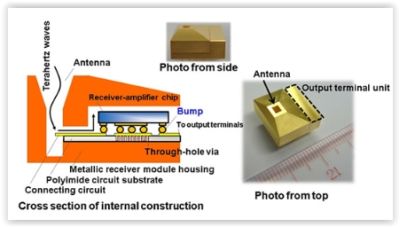
Note this section from the linked Fujitsu news release:
A portion of these research results were obtained through "R&D Program on Multi-tens Gigabit Wireless Communication Technology at Subterahertz Frequencies," a research program commissioned by Japan's Ministry of Internal Affairs and Communications as part of its "Research and Development Project for Expansion of Radio Spectrum Resources."
Yes, Japan, Inc. is partially funding this R&D through the very same agency that is FCC's Japanese counterpart! Now do you think Fujitsu is losing sleep about regulatory delay when it is ready to market this technology?
Such state capitalism is not the US system and should not be the US system. But in highly regulated areas like spectrum how can US entities compete against Europe, Inc. or Japan, Inc.? The answer is increasing transparency of spectra policy as well as its timeliness.
Why is Qualcomm a US company? Qualcomm was incorporates in July 1985 a few months after the May 1985 Docket 81-413 decision that permitted general use of sported spectrum in 3 unlicensed bands. According to cofounder Viterbi this stimulated the capital formation needed to get things rolling and within 2 years Qualcomm got FCC approval for its CDMA cellular technology - unbelievably controversial at the time.
At the end of the Declaration of Independence are the words "we mutually pledge to each other our Lives, our Fortunes, and our sacred Honor.” Qualcomm founders Viterbi and Jacobs may not have pledged their "lives" to get the company founded, but they certainly pledged their "fortunes" and "sacred honor" as 2 major leaders of communications theory and technology at the time. But they were able to get timely and transparent treatment from FCC at that time and a major company now results that contributes to US leadership in telecom technology.
Let's face up to the reality of state capitalism in our economic competitors and see what can be done to "level the playing field". I think speed and transparency for new technology would be a good step. Who knows, maybe even FCC compliance with Section 7 of the Communications Act after these many years might be nice step?
FCC Approves MSS Part 5 Reconsideration Request
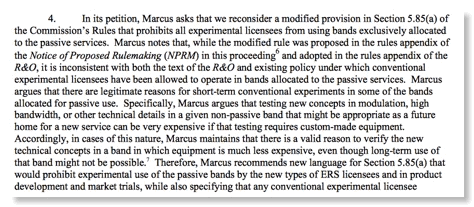
On July 8 FCC released an MO&O&FNPRM in Docket 10-236, formally captioned “Promoting Expanded Opportunities for Radio Experimentation and Market Trials under Part 5 of the Commission's Rules and Streamlining Other Related Rules”. This decision deals with 3 reconsideration requests, one of which was filed by your blogger. They relate to the January 31, 2013 FCC decision to revise the experimental licensing rules. In that decision the new rules forbid for the first time all experimental licenses in bands with only passive allocations. While this language had been in the NPRM’s draft rules, it was never mentioned in either the discussion sections of the NPRM or the R&O and quite probably was a drafting error.
We got involved in this issue after signing a new client in May 2013 who was having problems getting experimental licenses for millimeterwave technology experiments. In researching the issue, we noticed that the new rules were about to go into effect that would have made the task nearly impossible due to a new prohibition on any experiment in any passive only band regardless of its impact on passive spectrum users. Having noticed this 2 days before the reconsideration filing deadline, it was not possible to convince the new client to both file and approve the drafting so as a public service we did it pro se and filed our own Petition for Reconsideration. We subsequently got supporting comments from both Boeing and Battelle Memorial Institute. No party opposed this issue.
The Commission apparently agreed with our logic stating
“As Marcus observes, Section 5.85(a) of the rules appendix in the R&O is inconsistent with both our existing treatment of conventional ERS licenses and the text of the R&O. This inconsistency arose in the NPRM, where the text proposed that only program licenses would be prohibited from using “restricted” bands (including passive service bands) listed in Section 15.205(a) of the Commission’s Rules. In contrast, Section 5.85(a) of the rules appendix proposed that all experimental use of “any frequency or frequency band exclusively allocated to the passive services” be prohibited. This inconsistency was not addressed by any commenting party, but the Commission’s stated intent in the text of the R&O was to continue previous practice regarding conventional ERS licenses.”
The new rules have the following reasonable safeguards to minimize unnecessary emissions in the passive bands:
§ 5.85 Frequencies and policy governing their assignment.
(a)(1) Stations operating in the Experimental Radio Service may be authorized to use any Federal or non-Federal frequency designated in the Table of Frequency Allocations set forth in part 2 of this chapter, provided that the need for the frequency requested is fully justified by the applicant. Stations authorized under Subparts E and F are subject to additional restrictions.
(2) Applications to use any frequency or frequency band exclusively allocated to the passive services (including the radio astronomy service) must include an explicit justification of why nearby bands that have non-passive allocations are not adequate for the experiment. Such applications must also state that the applicant acknowledges that long term or multiple location use of passive bands is not possible and that the applicant intends to transition any long-term use to a band with appropriate allocations.” (These last two sentences are a minor modification of our proposed wording on p. 14 of our Petition.)
When Docket 10-236 was initiated the Commission boldly stated
“The Federal Communications Commission today launched two proceedings that will help to promote investment and create jobs in developing innovative spectrum-efficient technologies and services to help meet the growing demand for wireless broadband services. The first action is a Notice of Proposed Rulemaking that seeks to expand the FCCÆs existing Experimental Radio Service rules to promote cutting-edge research and foster development of new wireless technologies, devices, and applications.”
Chairman Genachowski went on to state:
“With these two items, we build on our efforts to use spectrum more efficiently and in ways that deliver the highest value for the American people, and to encourage groundbreaking innovation….The goal is to accelerate innovation – to reduce the time for an idea to get from the lab to the market. A more extensive experimental licensing program would also help the FCC make smarter, faster decisions, by giving us on-the-ground intelligence on interference issues, and insight into the development of new cutting edge technologies. Encouraging research and development is vital to our objective of making the U.S. the spawning ground for the great technological advances of tomorrow. Past advances in technology, such as cellular networks and improvements in digital transmission techniques have led to vastly improved efficiency in spectrum use.”
While no one could disagree with these goals, this proceeding — like many other spectrum policy issues that are not the focus of large trade associations — is limping along on a very low priority and in the FCC as presently funded and operating that means things are getting done very slowly. Note that the revised rules in the R&O only went into effect 5 months after the adoption and release of the R&O, no doubt due to “back office problems” due to short staffing in the unglamorous parts of FCC where “there rubber hits the road”. Note also that while this docket adopted the new program license category for experiments, these are not yet available due to delays in getting funding within FCC to update the website for applications and then more back office problems with OMB approval of information requests.
Finally, note that this reconsideration under was related a little more than 2 years after the filing of reconsideration requests. This type of delay is typical for all spectrum items not related to incentive auction issues. (Note that the delays dealing with Docket 10-4 and the FM/LTE problem show that even the cellular industry can not get timely attention on non-incentive auction issues!) We note that some commissioners think there is currently too much delegated authority to FCC staff. Look at the new decisions and think about whether any of these issues needed or gained value from deliberations from 5 presidential appointees confirmed by the Senate?
In the coming months a major issue in this blog will be improving FCC spectrum policy productivity to keep up with the dynamic requirements of the spectrum-related industries and to help US competitiveness. We believe that productivity can be improved without new legislation, although new funding may be needed. (FCC costs are matched by user fees so new funding would not involve new tax dollars.)
UPDATE
Discussion of same decision from our friends at CommLawBlog.
Should FCC Clean Up Its Spectrum Policy Backlog Before Reviewing Another Cable Merger?
Charter Communications expected to acquire Time Warner Cable in $55 billion deal http://t.co/jzM3wSG7NQ
— Washington Post (@washingtonpost) May 25, 2015This weekend word broke on yet another cable merger. We have no view on the merits of this merger, or for that matter on the merits of most mergers. But such mergers compete for scarce attention at FCC as it presently operates and detracts from its other duties such as Title III technical policy issues other than more spectrum below 5 GHz for the cellular industry. Even though the merger has not even been formally filed, Chmn. Wheeler has already issued today a public statement before 8:45 AM promising to review it. At least he did not promise quick action.
But what about the statutory promise of 47 USC 157(b) for timely action on “new technology” deliberations? What about new technology deliberations at FCC that seem to be stalled? For example:
- Wireless Innovation NOI - Docket 09-157 (8/27/09)
- Petition of South Carolina Department of Corrections and 30 other state corrections agencies on jamming cell phones in prisons (7/13/2009) (This was finally included in Docket 13-111 after having been never placed on notice for public comment and that docket is also languishing!)
- FWCC 42 GHz petition (5/9/12)
- Issue of interference from FM broadcast stations to 700 MHz LTE cellular base stations apparently resulting from a conflict between cellular rules and broadcasting rules (Since FCC has never acknowledged this issue, we will give it a date of 2 years ago)
- IEEE-USA petition for a declaratory ruling on whether 7 presumptively applies to technology above 95 GHz where there are presently no FCC rules (7/1/13)
- Battelle petition for Fixed service rules at 102-109.5 GHz (2/6/14)
- NOI on Mobile Service above 24 GHz (10/17/14) - Note that while not much time has elapsed, Ofcom, FCC’s UK counterpart has already issued two documents on this issue as well as a consultant’s findings since the issuance of this NOI! This is cutting edge technology moving quickly with government funding in many other countries, but uncertainties with FCC’s position are deterring private capital formation in USA in this technology.
- (While we can’t attach a date to it, the FCC’s continuing silence on all matter associated with spectrum for UAV’s/drones just drones on as the general issue of civil drones attracts ever growing attention. While there appears to be a dialogue between FAA and FCC on the issue, there is no statement on where drones may or may not use spectrum or any proposals.
Perhaps FCC has a valid viewpoint with its secret interpretation of the Communications Act that Section 5(c) trumps the Section 7 requirement on timely action for new technology. But if this is so, perhaps the Commission should tell Congress and the public that Section 7’s promise is now moot and you should expect dilatory action on everything except corporate mergers and more spectrum for cellular carriers?
In preparing for a talk this week, I was reviewing a video placed on YouTube by MobileFuture, a lobbying group representing many cellular interests. I noticed this predicted outcome of not giving cellular interests all the spectrum they want:

The irony is that the Commission’s current paralysis on more spectrum for cellular carriers and corporate mergers, not to mention partisan feuding over net neutrality, has resulted in chilling innovation for other wireless technologies not of immediate interest to the cellular industry, even backhaul technologies such as in the FWCC and Battelle petitions! As our national competitors subsidize R&D for these technologies, the US risks losing technological leadership unless FCC gives some signals to the private sector. (See p. 8-14 of NYU WIRELESS Docket 14-177 Comments)
So a modest proposal: no action on the new merger request until FCC makes real progress on cleaning up its Title III backlog.
We could point out that while FCC has made a promise on timeliness on corporate mergers, the statutory promise of Section 7 would seem to take precedence unless FCC wants to put its cards on the table and publish its secret ruling about why Section 5(c) makes that moot.
FCC Congressional Spectrum Testimony & Millimeterwave Spectrum

Keeping the Pipeline Flowing
In the fall of 2014, the Commission unanimously initiated a proceeding to explore the feasibility of using bands above 24 GHz for mobile wireless broadband and other wireless applications.The Commission is taking a proactive approach to examine the future evolution of wireless broadband technologies and determine what steps to take to create a flexible regulatory environment in which these technologies can flourish.Conclusion
The Nation’s leadership in wireless, and our ability to meet the wireless needs of consumers, depends in large part on spectrum resources. We will continue to pursue effective spectrum policies, leveraging the tools Congress has provided. We will also look to this Subcommittee for assistance and guidance in developing new, innovative approaches to spectrum management, and standready to work with Congress and our federal partners towards these important goals.
We agree completely with the last paragraph. However, there previous paragraph raises serious questions about present FCC policy. While indeed FCC “unanimously initiated a proceeding to explore the feasibility of using bands above 24 GHz for mobile wireless broadband” in Docket 14-177, it has paid scant attention to other “spectrum frontier”issues before it and has tried to narrow the scope of Docket 14-177 to minimize its applicability to non-CMRS applications. See fn 64 of the NOI to see how the drafters were looking for excuses to do as little as possible in this proceeding. In that footnote, they reference the TAC report on Spectrum Frontiers saying “TAC suggested instead that the Commission should carefully balance the benefits and risks of adopting service rules in these bands and take an active role to establish a framework for coexistence with passive services.”
- So what is FCC now doing to “establish a framework for coexistence with passive services”?
- What about the bands above 24 GHz where there are no passive allocations at all? (e.g. 122.25-123 and 158.5-164 GHz)
- What about the bands above 24 GHz where the passive allocations are co-primary, not primary? (e.g. 102-109.5 GHz)
- What does FCC think that Sections 7(a) and 303(g) of the Communications Act actually mean?

Millimeter wave technology - It really is different
Why is FCC acting so slowly?
Japan's Abe’s robot panel aims to give drone industry an edge
Note the proposed synergy of aeronautical regulations and spectrum regulations.
Prime Minister Shinzo Abe speaks during the party's annual convention in Tokyo on Sunday. The Robot Revolution Realization Committee, an advisory panel appointed by Abe, will review existing radio and civil aeronautics laws and set up industry-run best practices for drones. | BLOOMBERG
Abe’s robot panel aims to give drone industry an edge
Reuters
The Abe administration is looking to fast-track industry-friendly regulation to give Japan’s drone sector an edge over the United States.
…
The Robot Revolution Realization Committee, an advisory panel appointed by Abe, will review existing radio and civil aeronautics laws and set up industry-run best practices for drones.Another panel is asking companies for ideas on how to open up new special economic zones in Tokyo and other big cities to drones on a test basis
…
.We want to keep an eye on the world’s drone market, starting with the United States, and consider Japan’s way of doing things,” said Tamotsu Nomakuchi, who heads the robot panel. “It’s not about copying other markets, but learning about them and creating something better.”
While FCC’s and NTIA’s silence on drone spectrum drones on, Japan Inc. is trying to get its act together for economic growth! Hey, isn’t NTIA part of the Commerce Department?
While inside sources mention ongoing discussions between FAA and FCC on drone issues, there is no public acknowledgment that such discussions have even occurred.
This issue is not just providing spectrum for drone use, it also involved deciding which spectrum is inappropriate for drone use. This may well include both cellular and Wi-Fi spectrum for various reasons such as limiting the impact of drone use at high altitudes on terrestrial users.
While the Commission and its staff are paralyzed over the “NN issue”, this important issue is getting no visible attention.
Maybe the specter of Japanese initiative might strike fear in some circles now and spur the FCC to end its inaction.
Title III called and is demanding some attention now!
New Technologies for Wi-Fi
The unlicensed crowed has not been sitting on its hands while all this new technology has been developed on the cellular side. IEEE Communications magazine in its November 2014 issue has a focus on the “The Future of Wi-Fi”.
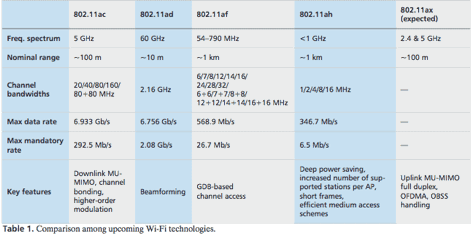
Above is a table from one of the Wi-Fi articles that gives some future versions of Wi-Fi along with their expected technical features.
These 4 papers give an overview of the new technologies that are expected to be implemented in licensed and unlicensed wireless communications in the next few years. The wireless mic gang might want to look at these technologies and ask why they are still obsessed with 1930s-based wideband FM. But other spectrum users, including federal users regulated by NTIA, might want to view these as a data point they should be judged by.
5G Will Probably Need an Aggregation of Technologies - Not Just More Spectrum

The new October 2014 issue of IEEE Wireless Communications magazine is a special issue on mulithop cellular - one of the technologies that will likely be part of 5G cellular. While there is no consensus yet on what exactly 5G will be, one article reports:
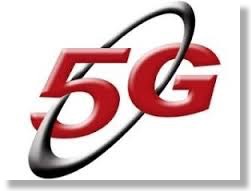
“it is widely agreed that in contrast to 4G networks, 5G network should achieve 1000 times the system capacity, 10 times the spectral efficiency, higher data rates (i.e., 10 Gb/s for cell center users and 5 Gb/s for cell edge users), 25 times the average cell throughput, and 5 times reduction in end-to-end (E2E) latency, and support 100 times more connected devices with 10 times longer battery life for low-power devices.”
By contrast, gsmhistory.com gives 3 different visions of 5G:
- A super-efficient “universal” mobile network that is always attentive to demand and where resources are continuously optimised to deliver a performance that is “always sufficient” – so users will perceive that they are connected to a network of infinite bandwidth. It would not just be data speed performance that is optimised but low latency needed by applications such as the Internet of Things. It is a revolution in “efficiency” delivering much better performing networks for a lower cost of investment. (Such networks are sometimes called DAN or Demand Attentive Networks). It would re-purpose existing spectrum to work in more efficient ways.
- A super-fast “mobile” network comprising the next generation of small cells densely clustered together to give a contiguous coverage over at least urban areas and delivering peak data rates of up to 1 Gb/s. It gets the world to the final frontier for true “wide area mobility”. Spectrum for this would be under 4 GHz (in order to make wide area coverage economically feasible). Since nobody is likely to reserve spectrum for 5G such a network would enter the market through advanced spectrum sharing – so in this vision 5G might be the first global implementation of Dynamic Spectrum Access. The band 3.4-3.6 GHz has been talked about for such a “spectrum sharing” market entry for 5G.
- A converged wireless-fiber network that uses, for the first time for wireless Internet access, the millimeter wave bands (20 – 60 GHz) so as to allow very wide bandwidth radio channels able to support data access speeds of up to 10 Gb/s. The connection essentially comprises “short” wireless links on the end of local fiber optic cable. It takes data over wireless to the state of the art. But this very high data speed comes at a price for consumers in terms of very much reduced coverage. It would be more a “nomadic” service (like WiFi) ie to fixed locations rather than a wide area “mobile” service

- Advanced coding and modulation techniques for 5G such as non-orthogonal wave form (NOMA).
- Spatial modulation (SM)
- Millimeter wave (mmWave)
- Visible light communication (VLC)
- Massive MIMO
- Cognitive radio networks (CRNs)
- Integration of Wi-Fi and core
- Local caching
- New heterogenous architecture - separate indoor and outdoor technologies
- Direct mobile-to-mobile communications
The introductory editorial explains the significance of the last point
“It has been more than a decade since the multihop cellular network (MCN) architecture was first proposed and analyzed in 2000. As the transmission range decreases k times, the number of simultaneous transmissions and hop count increase by k squared and k times, respectively, which leads to k times cellular capacity increase. Fundamental research projects have demonstrated the benefits of MCN interms of system capacity, service coverage, and network connectivity. Many special issues have been devoted to this stream of research. The actual concept behind the MCN architecture could be regarded as a hybrid of mobile ad hoc networks (MANETs) and cellular networks. This concept of “relaying within a cell” also pushed standard bodies to consider solutions embedded with mesh or ad hoc architectures, such as IEEE 802.11s, IEEE 802.15.5 , and IEEE 802.16j . Now, in the recent standards of the Third Generation Partnership Project (3GPP), Proximity-Based Services (ProSe) related work items also cover the MCN concept. In addition to device-to-device (D2D) direct communications, user equipment (UE)–UE relay and UE–network relay are also supported features.”
Note that in the above discussion new spectrum is included, but is not a “magic bullet” to achieve 5G goals of capacity increase. Synergy among a variety of approaches is needed for such increases. Although not explicitly mentioned, a massive increase of sites for cellular infrastructure is also needed, as has been previously discussed.
Note also that there is a dynamic interaction between unlicensed technology discussed in IEEE802 and licensed technology discussed in fora such as 3GPP. For example, LTE is a close technological cousin of WiMax. These interactions between the licensed and unlicensed communities are beneficial for all involved, although this is rarely discussed in policy circles.
So why is new spectrum the only 5G issue getting attention at FCC?
866 Mbps Achieved in Unlicensed 60 GHz Band
.Samsung Electronics announced the development of its 60GHz Wi-Fi technology that enables data transmission speeds of up to 4.6Gbps, or 575MB per second, a five-fold increase from 866Mbps, or 108MB per second, the maximum speed possible with existing consumer electronics devices. As a result, a 1GB movie will take less than three seconds to transfer between devices, while uncompressed high-definition videos can easily be streamed from mobile devices to TVs in real-time without any delay.
“Samsung has successfully overcome the barriers to the commercialization of 60GHz millimeter-wave band Wi-Fi technology, and looks forward to commercializing this breakthrough technology,” said Kim Chang Yong, Head of DMC R&D Center of Samsung Electronics. “New and innovative changes await Samsung’s next-generation devices, while new possibilities have been opened up for the future development of Wi-Fi technology.”
Unlike the existing 2.4GHz and 5GHz Wi-Fi technologies, Samsung’s 802.11ad standard 60GHz Wi-Fi technology maintains maximum speed by eliminating co-channel interference, regardless of the number of devices using the same network. By doing so, Samsung’s new technology removes the gap between theoretical and actual speeds, and exhibits actual speed that is more than 10 times faster than that of 2.4GHz and 5GHz Wi-Fi technologies.
Until now, there have been significant challenges in commercially adopting 60GHz Wi-Fi technology , as millimeter waves that travel by line-of-sight has weak penetration properties and is susceptible to path loss, resulting in poor signal and data performance. By leveraging millimeter-wave circuit design and high performance modem technologies and by developing wide-coverage beam-forming antenna, Samsung was able to successfully achieve the highest quality, commercially viable 60GHz Wi-Fi technology.
In addition, Samsung also enhanced the overall signal quality by developing the world’s first micro beam-forming control technology that optimizes the communications module in less than 1/3,000 seconds, in case of any changes in the communications environment. The company also developed the world’s first method that allows multiple devices to connect simultaneously to a network.
As is the case with the 2.4GHz and 5GHz spectrum, the 60GHz is an unlicensed band spectrum across the world, and commercialization is expected as early as next year. Samsung plans to apply this new technology to a wide range of products, including audio visual and medical devices, as well as telecommunications equipment. The technology will also be integral to developments relevant to the Samsung Smart Home and other initiatives related to the Internet of Things
Note the first sentence of the last paragraph: “As is the case with the 2.4GHz and 5GHz spectrum, the 60GHz is an unlicensed band spectrum across the world”. This did not happen by accident. It happened because of FCC initiatives in the 1980s and 90s that recognized technological advances had made new technology possible that was prohibited by anachronistic FCC rules at those times. The initiatives removed those prohibitions but did not require incumbent users to change their operations on bit nor did it increase their interference risk. As a result we have had technical innovation and economic economic growth.
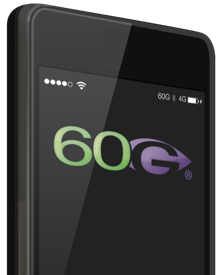
While other WiGig companies like Intel, Wilocity (now owned by Qualcomm) and Nitero have been developing super-fast radios that work 60GHz channel, Samsung claims they’ve actually produced these enhanced speeds by fixing interference issues caused by other devices on the channel.
Now the problem is that the new NOI is rumored to contain a discussion about possible partial or total repurposing of the 60 GHz band for cellular communications, presumably on a licensed basis. The question to be considered on the 8th Floor is how will the fording of the 60 GHz discussion impact capital formation for innovative unlicensed 60 GHz technologies. We are sure the 60 GHz companies have less visibility on the 8th Floor than the major CTIA members and their insatiable demand for spectrum.
We hope the 8th Floor considers carefully the wording of such discussion and its impact on capital formation for ongoing unlicensed 60 GHz systems.
Chmn. Wheeler, Tear Down This 95 GHz Wall!

On October 17, FCC will consider a millimeter wave (mmW) NOI that will be the first major mmW deliberation there in more than a decade. mmW is sometimes called the “spectrum frontier” and is the upper end of radio spectrum that is enabled by breakthrough technology. Indeed, a major motivation for the NOI is that the work of Ted Rappaport of NYU and others has shown that mobile use above 24 GHz is practical.
(Your blogger recalls that in the early 1980s when Motorola was pushing for more Part 90 sharing of UHF TV spectrum - an action that indirectly resulted in DTV due to an NAB backlash - Motorola and others claimed land mobile above 1 GHz was physically impossible!)
Description of 10/17 NOI from FCC Tentative Agenda
Due to military R&D, US firms are the leaders in basic mmW technology, but commercial mmW applications lag in part due to outdated FCC policies and the general procedure of FCC to wait for petitions its in inbox. Does FCC really think that it is easy to raise capital for moving technology from IEEE journals to the marketplace win part of the process is getting FCC to act on a rulemaking to permit the new technology? As part of my teaching last year, I asked 3 prominent communications attorneys in DC how long they thought it would take for FCC to act on approving a new technology using the verging spectrum above 95 GHz. The answers were all in the 3-5 year range!
This is not how we facilitate US technological competitiveness and economic growth. The roots of Wi-Fi and Bluetooth was a policy of FCC Chairman Ferris, later supported by Chairman Fowler, that FCC should identify promising technologies held back by anachronistic FCC policies and modify those policies to allow the technologies - with due deference to others who might be adversely affected - but not to require the new technologies. Indeed, Qualcomm cofounder Andrew Viterbi has said that the May 1985 FCC spread spectrum decision was important in enabling the final capital formation for the incorporation of Qualcomm 3 months later as it showed real FCC interest in CDMA which was then opposed by most mainstream industry players. (Cofounder Irwin Jacobs and the current Qualcomm management differ on this point and some others about the early company history.)
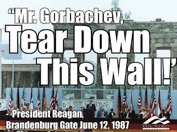
Now FCC has an analogous wall in spectrum policy at 95 GHz, depicted at the top of this post. While FCC (and ITU) has spectrum allocation up to 275 GHz, it has no unlicensed or licensed service rules above 95 GHz, a point reached in October 2003. At left is a Japanese 125 GHz system used at the 2008 Beijing Olympics in quantity for moving view from stadiums to the broadcast center. Use of similar technology is not permitted under current FCC Rules! So is it surprising that despite US leadership in millimeter wave components no such systems are being made in USA?
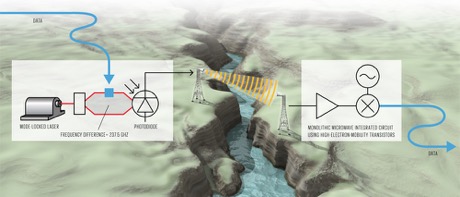
Above is a diagram of a German 237 GHz System exceeding 100 Gbits/s. Not only is its sale and use illegal in USA, but such an experiment probably could not have even been authorized due to the recent glitch in §5.85(a) that came about in the Report and Order of Docket 10-236 that for the first time forbids all experiments in passive bands. This change was made without any explanation and without any supporting comments. A timely filed Petition for Reconsideration on this issue has received no objections in more than a year and is supported by others, yet the matter is still unresolved at FCC. (Note, if FCC can not complete the whole reconsideration order on this docket in a timely way, it could at least issue a public notice announcing an interim liberal waiver policy for mmW experiments that impinge on passive bands based on whether there will actually be interference at the place and time of the experiment and NTIA - home of “spectrum sharing is the new normal” - could say that it supports such a policy as all such bands are G/NG shared.)
So here is what we urge FCC to do at the 10/17 meeting:
- Make clear in the NOI that the wall at 95 GHz is not intentional and is not a fundamental barrier to any proposed mmW uses.
- Make clear that despite theTentative Agenda description given above for the NOI that FCC is open to consider all uses of spectrum in the mmW bands, fixed, mobile and others and promises timely consideration of new proposals in order to support US competitiveness in mmW technology
Sen. Fischer Introduces S. 2817 to Urge FCC Compliance with Section 7

Section 7, passed over 30 years ago is brief:
(a) It shall be the policy of the United States to encourage the provision of new technologies and services to the public. Any person or party (other than the Commission) who opposes a new technology or service proposed to be permitted under this chapter shall have the burden to demonstrate that such proposal is inconsistent with the public interest.
(b) The Commission shall determine whether any new technology or service proposed in a petition or application is in the public interest within one year after such petition or application is filed. If the Commission initiates its own proceeding for a new technology or service, such proceeding shall be completed within 12 months after it is initiated.
It basically puts the burden of proof on those who oppose new technology and sets a schedule for deliberations on new technology, FCC has consistently ignored both provisions.
Sen. Fischer’s bill assigns 2 new functions to the FCC Office of Strategic Planning and Policy Analysis
(A) take steps to ensure that the Commission complies with each deadline under subsection (b) (of section 7);
(B) review each regulation proposed by the Commission and analyze the impact of the regulation on innovation, economic growth, andjob creation;
Now in a well functioning agency this congressional tinkering wouldn’t be needed. But there is something in the FCC’s hidebound culture under both parties that has resulted in a 30 year consistent avoidance of Section 7.
Let’s not be naive: a junior senator from the minority party in the Senate without cosponsors is not going to change FCC’s long habit of ignoring this provision of its statute. But maybe she will get more attention than an obscure spectrum blogger! Maybe she can get FCC to explain why it continues to ignore this part of its statute?
Section 7 is not a perfect piece of legislation as presently written. But if FCC doesn’t like it, why hasn’t it proposed any changes in 30 years?
Field of Dreams & Spectrum Policy
This week, the 80th anniversary of the Communications Act of 1934, is also the 25th anniversary of “Field of Dreams”, the movie most remembered for the line “If you build it … they will come”. While I recall that President Bush (41) publicly said he was confused about the movie, President Bush (43) actually was a great fan.
The connection to spectrum policy? Classic FCC spectrum policy (along with spectrum policy in other places) was prescriptive - that is users could do A and B, but not C if C was not explicitly allowed. Thus when I joined FCC in 1979, land mobile (Part 90) users were allowed AM and FM modulation and it took a long series of rule makings, some of which inconsistent in their final technical details details, to allow digital modulation for all users. By contrast, today’s rules are generally (broadcasting and public safety being major exceptions) proscriptive in that they tell you what you may not do - generally things that would result in interference to other users.
The reason why the 1981-85 rulemaking that brought forth Wi-Fi, Bluetooth, ZigBee and many other less known products was so controversial that it resulted in an attempt to fire your blogger after the rules were adopted was that it was an earlier action to move away from this prescriptive model. The rules adopted in Docket 81-413, now updated and codified as 15.247, did not say “let there be Wi-Fi”, they said “here is this spectrum, here are rules that prevent harm to anyone else, feel free to innovate and offer new products to the public and let’s see where this goes! “ (In truth, in 1985 wired/Ethernet LANs were nonexistent in offices and homes and there are no interest in any type of wireless LAN as a product for serial production. But the flexibility grand in the Docket 81-413 R&O meant that when interest developed for RLANs within a few years those interested did not have to come to FCC and grovel for permission for years. Thus they had timely market access and history was made!)
So as we near the 1 year anniversary of the IEEE-USA petition for FCC on the spectrum above 95 GHz that now lacks any rules (and is hence implicitly forbidden for normal licensed or unlicensed use) today let us ponder what we gain by having no such rules or even a defined path to such rules. In the Docket 81-413 rulemaking most commenters were opposed saying the technology under discussion was “blue sky” and had no demand. Yet within 2 years commercial products were available. A few years later came Wi-Fi and Bluetooth -- now “applications that have changed our world”.
Let us ponder of the lessons of “If you build it … they will come” and also the spectrum policy variant: “If you allow it .. they may well build it”. Let’s see if we can convert most FCC spectrum rules from prescriptive to proscriptive structure. (The cellular rules generally have this approach already.)
ABC US News | ABC Celebrity News
IEEE-USA Petition to FCC on Speeding >95 GHz Deliberations Under Terms of 47 USC 157
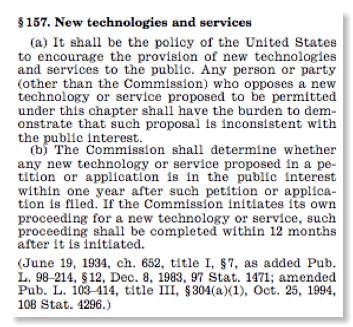
Section 7 of the Communications Act, shown above, was passed by Congress in 1983 and signed by President Reagan. It was then ignored in a bipartisan way by all FCC chairmen and virtually all commissioners for nearly 30 years. As reported here almost a year ago, it was “rediscovered” by Comm. Ajit Pai and was the focus of a speech he gave at Carnegie Mellon University on July 18, 2012.
On July 1, IEEE-USA, the US arm of the multinational engineering society filed at FCC a petition to ask to a declaratory ruling by the Commission that technology above 95 GHz presumptively qualifies at new technology under Section 7. Why 95 GHz? That is the upper limit for both licensed radio systems and unlicensed use under present rules.
(Part 18 ISM equipment may operate at 2 narrow bands above 95 GHz and Amateur Radio Service licensees have access to 3 bands above 95 GHz as well as “above 275 GHz”. Neither of these exceptions will stimulate a market for commercial products.)
The IEEE-USA petition seeks to have FCC presumptively declare that technology above 95 GHz is “new technology” in the context of Section 7 and thus entitled to the “burden” test if Section 7(a) and the timeliness requirement of Section 7(b).
mmW antennas & a dime

But the real issue here is uncertainty about FCC policy and the resulting regulatory risk that discourages capital formation for innovative technology. In the past few months I asked 5 prominent lawyers who specialize in spectrum issues how long it would take to a developer of >95 GHz technology to get FCC rules in place for normal sale and licensing (or unlicensed use) of the technology. One said 2 years, the other 4 said 4-5 years based on recent FCC performance in proceedings like UWB, AWS-3, and LightSquared.
Venture capitalists and “angels” have many people seeking funding for innovative technologies, most of whom are not subject to the regulatory uncertainties of FCC wireless technology regulation. These other technologies are therefore much more attractive to such capital than innovative wireless technology.
Furthermore, our major international competitor countries have a “state capitalism” viewpoint of wireless technology and regulation where the government “encourages” investment in chosen technologies, in some cases with government-controlled funding and coordinates spectrum policy to match the investments.
That is not the US system and probably should not be the US system. But it puts our technology developers, as well as our international competitiveness, at a real disadvantage if FCC does not consider such innovative technology in a timely way.
Hopefully FCC will request public comment on this petition quickly.
vox populi, vox dei
Comm. Pai's First Public Speech Hits the Bull's Eye on Innovation
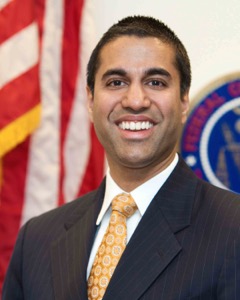
In his first major speech as a member of the Federal Communications Commission (FCC), Ajit Pai on Wednesday proposed the creation of an office for expediting the reviews of new technologies and services. In the speech at Carnegie Mellon University in Pittsburgh, Commissioner Pai, a Republican who joined the FCC in May, accused his agency of moving too slowly and stifling growth in the communications industry.
In the speech at CMU also talked at length about Section 7 of the Communications Act, a section so rarely mentioned at FCC that your blogger was seriously wondering whether it was redacted from all copies of the Act at FCC. While ignored consistently at FCC, Section 7 has been a recurring topic on this blog and there are indications that Comm. Pai’s interest might have been influenced by the discussion here.
Here is Comm. Pai’s discussion of Section 7 in case you are rusty on the details:
Now, you might be wondering: What is Section 7 of the Communications Act? You’re not alone; many communications lawyers don’t know what it is.
Let me quote the important part of Section 7, the neglected stepchild of communications law: “The Commission shall determine whether any new technology or service proposed in a petition or application is in the public interest within one year after such petition or application is filed.”
Looking at that provision, the message from Congress is clear: The Commission should make the deployment of new technologies and new services a . a priority, resolving any concerns about them within a year.
Comm. Pai proposes a new “Office of Entrepreneurial Innovation” for FCC although he suggests that this might be done by transforming the present the Office of Strategic Planning and Policy Analysis.
He states
(I)f we create an Office of Entrepreneurial Innovation, shepherding proposals for new technologies or services through the FCC will become an institutional priority and send the right signals to the marketplace. Entrepreneurs need an advocate at the FCC—one that will hold us accountable if we delay, rather than decide. And if OEI succeeds in its mission, we will see faster innovation, greater investment, and more job creation.
Finally on more general spectrum policy issues, Comm. Pai says
When it comes to spectrum policy, I believe in an “all of the above” approach. Does the FCC need to make available more spectrum bands for wireless broadband? Yes. Do we need to reform the federal government’s management of its spectrum so that more can be made available for private-sector use? Yes. Does the FCC need to expedite its review of secondary market transactions? Yes. Is there a place for geographic spectrum sharing? Yes. Is there a place for unlicensed use? Yes. Do we need to do more to promote the efficient use of spectrum? The answer, again, is yes.
A virtuoso performance! However, many incumbents with good access to 8th Floor decision making probably don’t agree that innovation, other than their own innovation, is a great idea. During its heyday as the dominant mobile radio manufacturer, the old Motorola maintained its market hegemony in Part 90 (private land mobile) market by manipulating FCC rules to keep out innovation that would disrupt their market share out of the marketplace. Indeed, this is the very reason Section 7 was passed in 1983 after Motorola and its allies in the Part 90 user community derailed a new land mobile radio technology (ACSB) from a new entrant!
The speech ended with these impressive words,
Finally, the agenda that I have described today is a work in progress. This speech should be the beginning of a conversation, not the end of one. If you have thoughts on how the FCC can help accelerate economic growth and job creation, tell me. If you have a new idea for how the FCC can become more nimble, promote investment, or allocate additional spectrum for mobile broadband, let me know. Please do not hesitate to contact my office. We have an open-door policy, and we encourage you to take advantage of it. You can even reach out to me on Twitter; my handle is @ajitpaifcc. It doesn’t matter whether you represent a Fortune 500 company, a start-up with three employees, a public interest group, or just yourself. A good idea is a good idea, and I want to hear as many of them as possible.
Although our nation has been going through tough times these last few years, I am confident that our economy will rebound strongly, and that the ICT sector can help lead the way. We see a glimpse of that future here in Pittsburgh. And if we pursue the right policies in Washington, DC, we can remove barriers to investment and innovation and unleash a wave of economic growth and job creation all across the country. Working together, I know we can make it happen. Thank you very much.
Some Possible New Year's Resolutions for the Cellular Industry
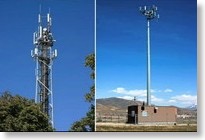
As we approach the New Year, here are some constructive suggestions for the cellular industry to think about as New Year’s resolutions. Long time readers will recognize that many have been discussed before in other contexts. Let me state first that I am a long time admirer of the cellular industry, its dynamic growth, and its general record of technical innovation. The cellular industry has also done much to improve public safety through its support for E-911, Amber Alerts, and programs to provide cell phones for domestic violence victims. But this industry has several blind spots as it has accumulated political power and FCC influence comparable to the power formerly held by entities such as the pre-divestiture AT&T, NAB, or the pre-1990 Motorola. sic transit gloria mundi
The purpose of this post is to point out constructively some of these blind spots that appear not to be in basic conflict with the fundamental goals of the industry in the hope that they may reconsider their positions in at least some of these areas. I note that while the main cellular players once were in strong opposition to the bidirectional amplifier/BDA issues now in Docket 10-4, they have moderated their position and appear to be working with responsible BDA manufacturers on technical standards for BDAs that control interference. I hope that similar reexamination is possible in the areas below:
1. Wireless technology innovation. The focus of the cellular industry is that innovation is good, but that the key to innovation is more licensed spectrum for their industry. They are happy with the current level of regulation so everyone should be also. This is clear from CTIA’s comments and reply comments in the Wireless Innovation NOI. They see no need to expedite deliberations of new technology, saying “Simply put, even for good ideas with broad appeal, resolution unfortunately can take a long time notwithstanding the desire of parties to speed the process along”. The fact that the endless drawn out FCC spectrum deliberations stifle capital formation for technical innovators is no concern for mainstream CMRS players with positive cash flow.
But Qualcomm was once a startup in an era when it got its key regulatory decision in 2 years after formation. The CDMA technology that this startup pioneered supplies a major fraction of the 2G market (VZW and Sprint) and is the core of all world’s 3G systems. But this type of disruptive wireless innovation os getting to be impossible due to regulatory stagnation but for the cellular industry and for other spectrum users that compete for cross elastic spectrum. Sadly, the cellular industry is firm with the status quo here.
Wa - harmony (Japanese)

What is the industry doing about this? Are they trying to increase sidetone levels so people don’t shout when using cell phones? Are they trying to make it easier to switch the ringer to a vibrate only/ “manners mode” as in Japan where all carriers have voluntarily agreed that a press of the “#” key toggles the unit to and from vibrate only mode? Are they researching ways for theaters and restaurants where people really want a semblance of quiet to use Bluetooth or a similar link to switch phones automatically to vibrate only? Kudos to Motorola for inviting Dr. Norman to talk on this issue. How much of this type of dialogue is going on now in the industry?
UPDATE
Suggested reading for cellular industry managers: “Wild Night at Philharmonic After Phone Interruption” describing a January 10 incident “in one of the quietest parts of the final movement of a gorgeous New York Philharmonic performance of Mahler's Ninth”.
3. Cell phones use in vehicles. Technology should improve life, not threaten it. In September 2011 NTSB recommended a ban on cell phone use in commercial vehicles (trucks and buses) after investigation of a Kentucky crash that killed 11 people. The industry was silent except for an e-mail message to your blogger saying “The wireless industry … does not oppose legislation that restricts the use of wireless communication by drivers." (This quote was never printed or posted anywhere else as far as can be determined.)
Then in December 2011 NTSB recommended to “ban the nonemergency use of portable electronic devices (other than those designed to support the driving task) for all drivers”. This time CTIA was no longer silent, saying “ As far as talking on wireless devices while driving, we defer to state and local lawmakers and their constituents as to what they believe are the most appropriate laws where they live.” This is not leadership, this is non opposition. If I was involved in a product or service that resulted in death on a regular basis as an unintended byproduct I would be a lot more concerned. Especially since talking in cars is not the main use of cell phones.
The NTSB recommendations are not perfect. For example they do not deal with new technology since all NTSB can do is investigate past accidents. Why doesn’t the industry do something more proactive like start a standards committee, or encourage DOT to start one, that can certify which technologies are safe enough for use in vehicles?
(But kudos to Sprint for breaking with the crowd and being a cosponsor of Oprah’s Oprah’s No Phone Zone website and its “No Phone Zone Pledge”.)
4. RF safety. Most of the cellular industry thinks that the public should be happy with their statements that cellphones meet FCC standards and are therefore safe. A decade ago, the industry fought FCC over the proposal to stop hiding SAR ratings for cell phone models in an obscure unmanageable database. As a previous blog post here has as a headline, “CTIA: Maybe Your RF Safety PR Strategy Isn't Working?” The past year has seen CTIA boycott San Francisco and got to court (with an initial partial victory) over a local ordinance requiring point of sale disclosure of SAR data. (The same data that Verizon Wireless openly discloses on their website for models they sell.)
Perhaps the industry does not want you to know about the secret of OETB65C. Stalin once said, “The people who cast the votes decide nothing. The people who count the votes decide everything.” So the SAR standards for cellphones in Sections 2.1091 and 2.1093 were subject to a notice and comment rulemaking that made 1.6 W/kg the SAR limit. But how is that really determined? In practice through the procedures of OETB65C which gives the manufacturers a lot of leeway as to what spacing from the simulated body they can use for measurements in the body, even if they do not provide a holder that would implement that distance and even if they don’t warn users not to put the device in their pocket. Both Time magazine and your blogger have written about this issue, but there seems denial at both FCC and industry on the issue.
There is no proof that cell phone radiation is dangerous. Indeed, some of the brain cancer claims made as clearly outrageous. (Considering there is no proof that cell phone radiation causes any pathology, why the focus on brain cancer - except that it is a very scary diagnosis.) But the web site of CTIA’s French counterpart is a lot more pragmatic than US industry sites on the risks and unknowns as well as the fact that some users may want to take extra precautions. The Swiss counterpart of EPA also has a site with pragmatic and practical information lacking in industry and government sites in the US.
5. Base stations and their environments. One of the issues driving the need for more CMRS spectrum is the difficulty of building base stations, particularly in suburban areas. Cellular capacity is a function of 3 factors: technology (e.g. 3G vs. 4G), infrastructure (number and nature of base stations, and amount of spectrum. Limits on one factor press demand on the others. For 2 decades industry has pressed Congress and FCC to limit the ability of local governments to control base station deployments with limited success. The reason is simple for the limited progress; as Tip O’Neill said famously, “All politics is local”. As long as base station designs “look like they are designed by engineers” with no regards for their surroundings in most cases, the neighbors will object.
This month’s IEEE Spectrum reports on a UK design contest for power pylons sponsored by a major electric utility, a national government agency, and the architect’s professional society, which resulted in several novel designs including the one above. Why can’t the US cellular industry help sponsor a similar contest for bold new ideas in base station design? The cost would be small compared to what they are spending on they lobbying war with the broadcasters as present.
6. “Spectrum scoring” or “How to count to 500”. The cellular industry originally demanded 800 MHz of new spectrum for CMRS although they are now accepting of the 500MHz NBP goal. But what spectrum counts towards the 500 MHz goal? Does every single Hertz have to be only in spectrum that meets standards developed in Europe to be manufactured in China? There are many types of wireless innovation other than making iPhone and iPad clones. Some of them involve using spectrum more efficiently. The focus on meeting international standards means that only innovators who want to plow through the complex international standards process can get market access in the US. Actions like PacTel’s decision to go with CDMA in the 1980s apparently is beyond consideration now.
While your blogger has no views against giving more spectrum to CMRS, many of us think the 500 MHz goal is impossible under the conditions for “counting” that the cellular industry has implicitly set with factors like nationwide 24/7 1000 ms/s access and in 3GPP specified bands. Although LTE systems can use unpaired spectrum, most of the spectrum on their wish list appears to be paired and symmetric. If FCC and NTIA come up with spectrum that doesn’t that meets all these criteria, does it “count”?
7. Provide communications for niche applications that otherwise contend for spectrum with CMRS. After the success of the iPhone, the CMRS focus seems to be on “killer apps”/knock out new products. Niche markets are of little or now interest unless they can be served with apps on standard hardware. Who needs little $100M markets. This is understandable from the MBA viewpoint.
But here is another viewpoint: Some niche markets compete for spectrum at FCC that is the same or comparable spectrum to what the cellular industry seeks. For example the medical community is clearly seeking more spectrum for short range applications. It is clear to many of us, even some in FCC, that the existing use of wireless microphones in UHF TV band “white space” is not sustainable in the long term except perhaps for uses involving only a few microphones like small churches and conference rooms - not theaters and major concerts. This is because of cellular industry pressure for UHF incentives auctions that will eventually tie up the same spectrum.
In the past, there was no alternative for the CMRS industry to serve these and other wireless niches. However, with the spectrum leasing provisions of Subpart X of Part 1 and today’s femtocell technology it is possible for cellular carriers to lease short range spectrum to users with other than standards cellular modulations/physical layers and without connection to the public network. A good example is the Qualcomm FlashLinq™ technology that will allow users to connect directly to each other with non standards modulations on spectrum leased from and under the control of a CMRS carrier. Maybe the specifics of FlashLinq™ are not perfect for the CMRS community, but it clearly shows the feasibility of new types of spectrum use in CMRS spectrum. Even if it is not a billion dollar market, its ability to “soak up” other spectrum uses that would otherwise compete for spectrum might make it attractive to openminded CMRS firms.

Until recently, the largest prepaid operator, TracFone, allowed users to activate a phone bought anonymously and “skip” the step to report name and address. However, the option of buying with cash bagfuls of prepaid phones at Walmart, activating them over the web with a false name and address, and selling them for criminal use is still quite real. Isn’t it odd that we more concerned about over-the-counter sales of Sudafed and Plan B than we are about bagfuls of anonymous cellphones?
Many countries require some identification before prepaid phones can be activated. This is a complex issue both because of the size of the market and the appeal of prepaid phones to market sectors who need them for legitimate economic and safety-related reasons but, as we know from the voter ID controversy, may lack or be unwilling to identify themselves in the standard ways. While I sincerely hope we never have a cellphone-related IED attack in this country, such an event would force a PATRIOT Act-like knee jerk reaction that could be more draconian that a deliberate process now to address the situation.
UPDATE
For those of you who wonder about the temerity of an industry outsider raising such questions about the cellular industry, let me point out the Verizon $2 “payment fee“/“convenience charge” kerfuffle that started just as this blog was first posted and ended a day later. Clearly, VZW, the largest cellular carrier in the US was out of touch with its customers on this issue and had to beat a hasty retreat. Perhaps the industry is also out of touch on the above issues?
UPDATE 2
On 1/7/12 CNN posted an article by bestselling author Bob Greene entitled “Is 2012 the year to hang up the phone?”
Story highlights:
There is growing chorus of officials, employers urging less cell phone useHe says NTSB warns against use in cars; bosses pushing back on personal calls at workHe says cell-phone distractions even affect surgeons and nurses; cut productivityIt may be impossible to take people's freedom of cell use away from them
So your blogger is not the only one seeing cell phone use backlash. Perhaps if the industry was more sensitive to the concerns listed above it might be in their own interest?
H.R. 3010 and its Likely Impact on Wireless Innovation
“The current regulatory system has become a barrier to economic growth and job creation. Federal regulations cost our economy $1.75 trillion each year. Employers are rightly concerned about the costs these regulations will impose on their businesses. So they stop hiring, stop spending and start saving for a bill from Big Brother. But rather than burdening businesses with more regulations, we need to free up employers so they can create jobs for American workers. The Regulatory Accountability Act does just that. It places permanent restrictions on regulatory agencies and restores accountability by requiring openness and transparency in the regulatory process. This is a bipartisan, bicameral bill that both parties, both houses of Congress and the President should support.”
The CRS summary of RAA states,
“Regulatory Accountability Act of 2011 - Amends the Administrative Procedure Act to revise and expand the requirements for federal agency rulemaking by requiring agencies, in making a rule, to base all preliminary and final determinations on evidence and to consider the legal authority under which the rule may be proposed, the specific nature and significance of the problem the agency may address with the rule, any reasonable alternatives for the rule, and the potential costs and benefits associated with such alternatives.
Requires agencies to publish advance notice of proposed rulemaking for major rules and for high-impact rules (rules having an annual cost on the economy of $100 million or $1 billion or more, respectively), which shall include a written statement identifying the nature and significance of the problem the agency may address with a rule, the legal authority under which the rule may be proposed, and a solicitation for written data and comments from interested persons.
Sets forth criteria for issuing major guidance (agency guidance that is likely to lead to an annual cost on the economy of $100 million or more, a major increase in cost or prices, or significant adverse effects on competition, employment, investment, productivity, innovation, or ability to compete).
Expands the scope of judicial review of agency rulemaking by allowing immediate review of rulemaking not in compliance with notice requirements and establishing a substantial evidence standard for affirming agency rulemaking decisions.
Thus the basic presumption of RAA is that ALL federal regulations add new burdens on industry and that Congress needs to make a major change to the 1946 Administrative Procedures Act to slow new regulations. While this is certainly true for many regulations from many agencies and also the reason why EPA is called by some the “employment prevention agency”, new FCC Title III technical regulations almost always have the impact of allowing for the first time new technologies and new products and contributing to economic growth and national competitiveness.
RAA would subject FCC to the provisions of Clinton-era EO 12866 including OMB review of new rules. It would also expands the grounds for judicial review - another sure way to slow down innovation.
In the Wireless Innovation NOI, the speed of FCC deliberations was raised as an impediment to technical innovation and the capital formation that it needs. Mitchell Lazarus, a well known lawyer who often is involved in innovative wireless technologies stated in his personal comments,
“The Commission's Rules are based largely on the technologies in place when they were written. New radio-based technologies often fail to satisfy those rules. The more novel an innovation, the less likely it is to comply. In consequence, a new wireless technology may need a Commission rulemaking or a waiver before it can reach the market. Technical proceedings in general, including those to authorize new technologies, have been dismayingly slow”
Lazarus ends with the recommendation that to speed wireless innovation FCC should have an exemption from the Administrative Procedures Act burdens that have accumulation in 65 years of case law and only be bound by the original statutory provisions. The RAA is above in the opposite direction and may well worsen the existing gridlock on innovative technology. Perhaps the provisions of RAA would be helpful at most other agencies and maybe even in much of FCC’s jurisdiction. But their application to technical Title III rule makings at FCC could have a disastrous implication for technical innovation and national competitiveness.
Of course, broadcast and cellular incumbents are the “haves” today and might welcome a slowdown in technical innovation that might encroach on their spectrum. Readers who think this might be reasonable are encouraged to read the previous blog entry about Ofcom’s CEO’s views on innovation and its impact.
But to say something good about RAA, § 553(f)(2) has the following provision that could help consideration of technical issues at FCC:‘‘The agency shall adopt a rule only on the basis of the best reasonably obtainable scientific, technical, economic, and other evidence and information concerning the need for, consequences of, and alternatives to the rule.” Of course, NTIA is subject to similar terms under existing Executive Branch policy on scientific integrity and it is not clear if they have had much impact there.
Regulatory Uncertainty and Investment in Wireless R&D
On the question of why wealth is not creating new jobs, Ryan stated the causes were
(U)ncertainty on taxes, uncertainty on regulation, uncertainty on debt, and therefore borrowing costs, interest rates and things like that. there is so much government induced uncertainty that it is putting a massive chilling effect on growth. I think that is something we can fix. That is something we can be focusing on as public policy leaders to fix one of the sources of instability, of uncertainty, of one of the depressors of economic growth. (0:50 - 1:26)
Businesses need to have to have some degree of certainty if they are going to plan and take a risk. We want to encourage risk taking. We want to encourage people to take their capital and put it to work, not put it in a bank, not put it in a bond, put it in a factory, put it in a business plan that increases employment. (1:50 - 2:10)
Similarly, the FCC’s longstanding de facto policy of indecision and delay on deliberations on new spectrum policy or whether new technology would cause ”harmful interference” on incumbent licensees results in huge regulatory uncertainty for capital formation in innovative wireless technology. Coupled to this is the Commission’s continual denial that Section 7 is part of the “law of the land”, a repeated topic on this blog. (Section 7 is not a perfect piece of legislation. But if the Commission feels it is unworkable as written, the proper procedure is to request repeal or modification -- not ignore it.)
Wireless R&D is not the only thing a tech savvy investor can invest in. There are less regulated fields like semiconductors, display technology, energy technology, and even biotech - many investors would prefer FDA-regulated technology over FCC-regulated wireless technology because FDA despite its many problems is more transparent that FCC Title III technical regulation! FCC uncertainty and delay adds to other investment risks and may make wireless technology R&D too risky for any rational investor.
While this discussion focuses on technological innovators and incumbents are sitting “fat and happy” with their ability to delay and tilt FCC new technology deliberations in their favor, they also face a risk that capital markets might someday realize that the huge value of their Title III licenses depends on the “metes and bounds” of these assets and in the present nontransparent system this raises regulatory uncertainty for the incumbents and hence increase investment risk. Increased transparency may be more credible to investors than K Street law firms on retainer to defend against innovators.
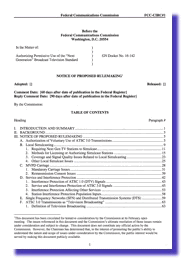
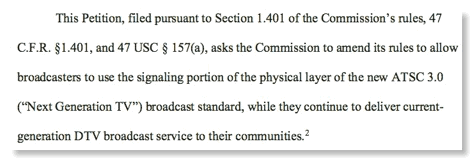
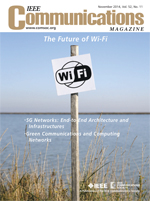
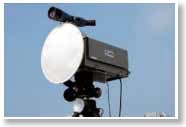
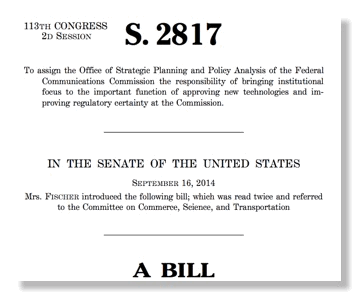
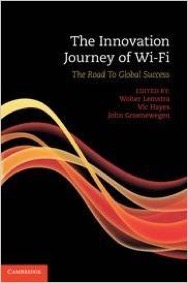


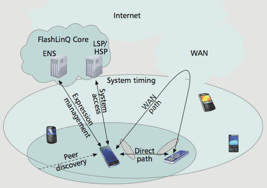
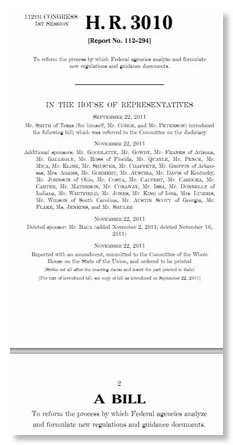




![Validate my RSS feed [Valid RSS]](valid-rss-rogers.png)

